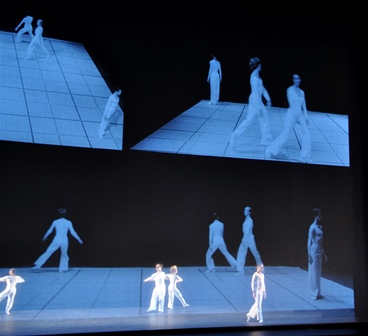25 October 2014, Théâtre de la ville, Paris, Festival d’automne
Lucinda Childs made her hour-long work Dance, performed to music by Philip Glass, in 1979. The work was revived in 2009 and a filmed version from 1979, shot by visual artist Sol LeWitt as his part in the 1979 collaboration, was digitally remastered and used as an accompanying component in the revival. I didn’t manage to catch Dance in Australia when it was shown at the Festival of Perth in 2012, but the revival is currently touring in the northern hemisphere and I was lucky enough to see it recently at the Festival d’automne.
The title, as notes for the production tell us, was inspired by Merce Cunningham’s statement that dance is expressive only of itself, and by Gertrude Stein’s remark that ‘A rose is a rose is a rose’. Dance is indeed ‘about’ dance. There is no narrative and the work is most commonly regarded as an iconic piece of late minimalist art. But behind the facade of minimalism is a structural and visual complexity.

The work consists of three separate sections each about the same length—twenty minutes. In the opening section, the dancers—eleven in the company I saw—move across the stage from left to right, mostly working in pairs, with their dancing pushed along comet-like by the Glass score. At first they seem to be repeating the same movements—small jetés (grands jetés style but done sideways); small turns; and off-centre, tilted movements—but gradually it becomes clear there are many small variations and changes of tempo, punctuated by moments of stillness, or moments when the stage is briefly empty. The footage, projected onto a scrim, follows the dancers’ real-time movements, giving two views of the choreography. At times the footage seems to be super-imposed onto the dancers. Sometimes still shots from the film appear. Sometimes single figures are there. Sometimes the projections are above the dancers, as if the stage space is a two-storeyed structure. Sometimes the screen is split.
This technique, finely integrated with the performance, produces some interesting results, not only because of the visual complexity it produces, but because it shows the different styles of the dancers of 1979 and those of today. While the dancers on film appeared to be much more relaxed and loose limbed, I admired the precision of the present company, especially in the arms and carriage of the upper body. Their dancing seemed to me to be much more aligned with the mathematical, or highly ordered qualities of Childs’ choreography.
The central section, a solo originally danced by Childs, begins with a larger than life-sized image of Childs, almost pushing itself into our space. At first it seems like a still from the footage, but then Childs blinks! After a while the image disappears and the solo in real-time begins, with choreography more focused on ‘every day style’ movements—casual walking and swinging of the arms.
In the final section the dancers work in fours and the floor patterns they create are square, or take on the form of a parallelogram, in contrast to the horizontal lines of the first section. The work comes to a climax superbly, with a quartet of dancers demonstrating the strength of the company’s technique—those fouettés sautés with arms whipping into stretched second position were beautifully executed. Then in a surprise move, which I probably should have expected, the work came to an abrupt end.
I was curious that the film showed Dance being performed on some kind of a floor cloth marked out in squares, large and small. Some had dark borders, others had lighter ones. It was like one of those puzzles that asks, ‘How many squares can you see in this drawing’? I assume this was Sol Le Witt’s work but I can’t be sure. I wondered if the original production was performed on this squared design, or whether it was created just for the film. But all in all Dance was a totally fascinating collaborative work full of intricacies, and splendidly performed.
Michelle Potter, 26 October 2014
I think that the squared floor-cloth is the original film decor from 1979 (I can’t find a photograph of the 1979 production, but it is what was used in 2001 by Ballet du Rhin), and in this respect (the geometry) you may find it interesting to refer to Childs ‘Calico Mingling’ of the early 1970s.
Thanks David. And for those interested, here is a link to a link for Calico Mingling: http://ubuweb.com/film/mangolte_calico.html
And to my surprise, today I was visiting the Centre Pompidou and found an old film of Childs performing in a work called Vehicle during one of those famous happenings called 9 Evenings: Theatre and Engineering, with which Robert Rauschenberg and others of that circle were involved, in, I think, 1968. Unfortunately it was not of the best quality but it did give an insight into Childs’ background in those avant-garde events of the 1960s.
She also took a curtain call at the Festival d’automne. What an elegant lady!
UPDATE: Just looked it up. It was 1965 that 9 Evenings took place.